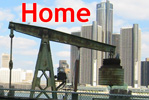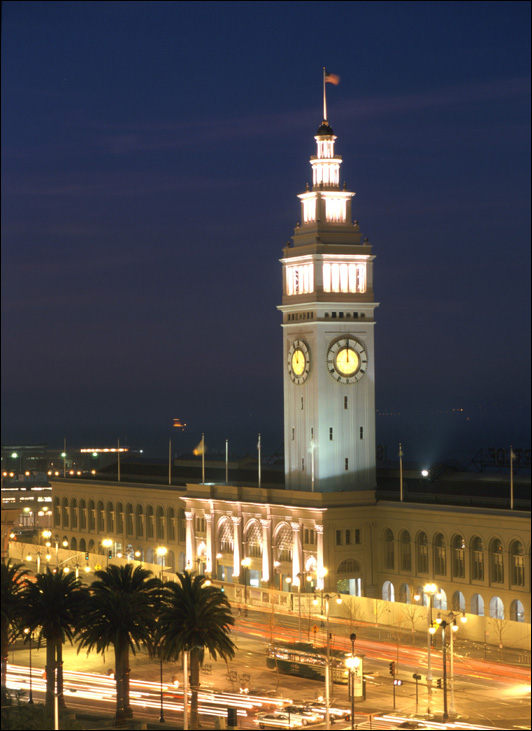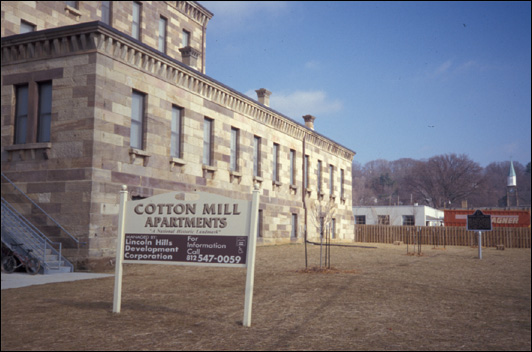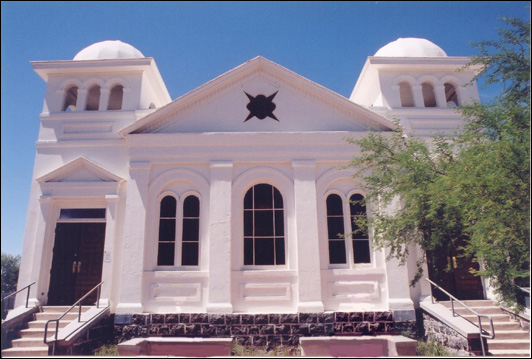

  |
|
last modified: Monday, December 19, 2005 10:35 AM |
|
Determining the Value of Historic Preservation |
|
Mary Jo Byrnes |
mjbyrn@gmail.com |
Qualitative expressions of the value of historic preservation often are dismissed by economists simply because they are not susceptible to standard economic (mathematically driven) methods of analysis. But these cultural values -- resisting easy quantification and mathematical treatment -- are essential to the nature of historic preservation and therefore must somehow remain part of the discourse on decision-making and other economic discourses on preservation·Applying standard quantitative, market-derived measures of historic preservation will not suffice -- a priori -- to express the full value of preservation as cultural expression and public good (Mason, "Economics" 3).
Photo: National Trust for Historic Preservation
 The preservation movement has steadily
gained momentum in the
The preservation movement has steadily
gained momentum in the
American voters, public officials and the courts have long supported the notion of historic preservation as a public good and an appropriate government function (Mason, "Economics"). As with other public goods, much of the debate about historic preservation centers on the magnitude and type of public funding to devote to these activities. This raises a variety of difficult questions on the proper pricing of historic preservation benefits. Economists can give straightforward answers to some, but many of the questions asked are more problematic and straightforward answers remain elusive. Public officials require quantitative expressions of costs and benefits as well as methodologies for evaluating benefit relative to alternative choices to facilitate decision making on planning policy and budget allocations at every level of government
The lack of methodologies is not simply an accounting problem. The limitations of current methodologies for valuing the full range of economic and cultural benefits that flow from preservation, and many other assets of our cultural heritage such as art, theatre and education, undoubtedly create a serious misrepresentation of their value to society with damaging implications for every sphere of human endeavor. "Neglecting to take into account the economic value of cultural heritage conservation and the full costs and benefits of policies, regulations, and projects with cultural components can lead to suboptimal allocation of resources in the sector, investment failure and continuous degradation of the worldās cultural assets" (Mourato 52). Though the attempt to capture cultural value in economic terms raises deep concerns about the precedence of the economic agenda over all others, people from both camps acknowledge the intractable problem of scarce resources and the need to find common ground (Bluestone et al. 19).
This article discusses the challenges to developing methodologies for measuring the full range of cultural and economic benefits. It begins with a discussion of the growing interest in preservation by economic development professionals and the rising demand for analytical tools sufficient to measuring the full range of preservation benefits with application to everyday policy issues. It discusses the challenges to economic analysts embodied in the very nature of historic preservation activity. Finally it considers the basic dilemma that bedevils the attempt to merge cultural and economic approaches to assessing the value of preservation. As planners grow more interested in merging economic and cultural approaches to economic development, the issue of valuation has become more significant. The articleās discussion of economic and cultural notions of value is one aspect of a much broader debate over the growing and perhaps undue influence of the economic way of thinking on all aspects of American life. The issues surrounding the valuation of preservation demonstrate a few of the challenges posed by the marketās incursion on the more sacred precincts of civic life.
Photo: Tom Paiva.
 The field of economic development
is increasingly turning its attention to the expressions of community culture
that appear to bestow competitive advantages for recruiting new business.
Voters and planners alike question the effectiveness
of costly incentive based strategies and are examining the importance of "quality
of life" factors in building and sustaining healthy economies. The
The field of economic development
is increasingly turning its attention to the expressions of community culture
that appear to bestow competitive advantages for recruiting new business.
Voters and planners alike question the effectiveness
of costly incentive based strategies and are examining the importance of "quality
of life" factors in building and sustaining healthy economies. The
The Brookings Institution Metropolitan Policy Program published a discussion paper in September 2005 that addressed the range of issues surrounding the economics of historic preservation. Author Randall Masonās review of the literature finds overwhelming evidence of positive economic benefits, but concludes that much more work needs to be done before economists can answer the basic pragmatic and policy questions surrounding preservation activity. Much of the empirical evidence on economic benefit flowing from preservation activity is highly situational, limited in focus, and difficult to extrapolate widely (Mason, "Economics" 16). More attention must be paid to the development of hybrid methodologies for articulating the full range of economic and cultural value embedded in preservation activities. In addition, simple expressions of the relative value of preservation compared to other forms of investment are required.
Economic concerns arise at every level of historic preservation activity. Individual investors must determine the profitability of rehabilitating a historic structure by examining the costs involved in construction and the possible returns on the investment in the form of rents. These figures are routinely compared to the costs and benefits of demolishing the building and constructing a new one in its place, or any number of other investment alternatives. The concerns of the individual investor are quite different from the issues public officials consider. Financial and more complex issues surround the decision making process when choosing between the rehab and redevelopment of an important community landmark and demolition and replacement of the building with a new high-rise housing development. Some of the questions raised by these different preservation scenarios can be addressed by standard tools of economic analysis, the others await the development of new methodologies to deliver satisfactory answers. A great variety of questions covering a range of multi-disciplinary issues are asked of preservation everyday, and they speak to the public and private, monetary and non monetary purposes of preservation activity.
Historic preservation, for example, can be a private good in that it offers a range of goods and services consumed by individuals and traded in markets (such as real estate). On the other hand, it can be intrinsically a public good, with benefits deriving collectively and provided not by markets, but by government or nonprofit groups. These differences lead to very different methods and degrees of complexity in assessing its value.(Mason, "Economics")
Photo:
 Mason finds that the standard real
estate pro forma, and economic impact studies or simple cost benefit analysis
using market data can measure the private benefits of preservation ("Economics" 16).
However it is the public benefits so intrinsic to the practice of historic
preservation that are more problematic. Public benefits include economic
(use) value, such as rent receipts, and non-economic nonuse values, such
as values of beauty, historic associations and the like. The use value of
preservation lends itself to economic analysis, but the nonuse values are
especially difficult to assess in economic terms. The public benefits are
of course the raison dāetre of historic preservation activity and are the
basis of public support for historic preservation policy. The investigation
into methods of measuring these benefits is a major challenge to economists
today and is the subject of a growing amount of research ("Economics" 16).
Mason finds that the standard real
estate pro forma, and economic impact studies or simple cost benefit analysis
using market data can measure the private benefits of preservation ("Economics" 16).
However it is the public benefits so intrinsic to the practice of historic
preservation that are more problematic. Public benefits include economic
(use) value, such as rent receipts, and non-economic nonuse values, such
as values of beauty, historic associations and the like. The use value of
preservation lends itself to economic analysis, but the nonuse values are
especially difficult to assess in economic terms. The public benefits are
of course the raison dāetre of historic preservation activity and are the
basis of public support for historic preservation policy. The investigation
into methods of measuring these benefits is a major challenge to economists
today and is the subject of a growing amount of research ("Economics" 16).
Methodologies that attempt to express the public good aspects of historic preservation quantitatively rely on various ways of making estimates of prices in hypothetical markets. Non market valuation methodologies applied to preservation activity include case studies, revealed preference studies, such as hedonic pricing or travel cost, stated preference studies such as contingent valuation, choice modeling and willingness to pay. Stated preference studies show promise for getting at non use value, but require considerable refinement (Mason, "Economics" 16).
The ultimate concern is that economists and economic practices insufficiently appreciate the wide range of values of cultural heritage. This, therefore, feeds the political resistance to providing the necessary finances for the preservation of cultural heritage, with the consequence that commercial activities take over. Economists, conversely, complain about culturalists who fail to acknowledge the economic realities regarding cultural heritage and efforts at conversation (Klamer and Zuidhof 23).
Opposing conceptions of value create most of the dissonance that disrupts the collaboration between economists and "culturalists." In very broad terms and ignoring many of the nuances, the conflict can be described as follows. In classic microeconomic theory the most important player is the individual consumer, household, firm, industry or government. The principle of consumer sovereignty asserts the autonomy of freely choosing consumers and their ultimate right to determine what is valuable and what is not (Klamer and Zuidhof 23). Value in economics is simply the benefit people attach to the consumption of a good. Valuation is simply an assessment of that value and is expressed in the market price, a simple equation that reduces all benefit to monetary terms, the universal language of the marketplace. The assumption is that consumers acting in their own interests determine the most efficient allocation of scarce resources. Market failure occurs when markets are unable to provide goods satisfactorily. Though some historic preservation activity is priced within the marketplace, it is generally considered by economists to embody the qualities of a public good and an externality.
Photo: National Trust for Historic Preservation.
 In the cultural sphere by contrast,
the most important category is the collective; benefits derive collectively
and are not provided by the markets but by governments or nonprofit groups.
The units of value are non-monetary and complex. For example, one object
of cultural heritage, such as George Washingtonās home at Mount Vernon, or
the plantationās slave shacks, or the panoramic view-shed, or the agricultural
exhibits, any one of these resources is embedded with many different kinds
of value, such as economic value, aesthetic value, political value, or educational
value. "The variety of values ascribed to a particular
object are matched by the variety of stakeholders participating in
the heritage conservation process. Balancing these values is one of the
most difficult challenges in making conservation decisions that satisfy
the needs of many stakeholders" (Mason, Getty 2) The multiplicity and variety
of values and the collective concern for numerous stakeholders embodies
a concept of value that overwhelms the rather crude (by comparison) arithmetic
of the marketplace.
In the cultural sphere by contrast,
the most important category is the collective; benefits derive collectively
and are not provided by the markets but by governments or nonprofit groups.
The units of value are non-monetary and complex. For example, one object
of cultural heritage, such as George Washingtonās home at Mount Vernon, or
the plantationās slave shacks, or the panoramic view-shed, or the agricultural
exhibits, any one of these resources is embedded with many different kinds
of value, such as economic value, aesthetic value, political value, or educational
value. "The variety of values ascribed to a particular
object are matched by the variety of stakeholders participating in
the heritage conservation process. Balancing these values is one of the
most difficult challenges in making conservation decisions that satisfy
the needs of many stakeholders" (Mason, Getty 2) The multiplicity and variety
of values and the collective concern for numerous stakeholders embodies
a concept of value that overwhelms the rather crude (by comparison) arithmetic
of the marketplace.
There are further distinctions to be made between the various types of value people attach to Mount Vernon or other heritage objects: option value, or the satisfaction of knowing the object is there to experience if one chooses; existence value, the satisfaction derived from the fact it exists or survives; bequest value, contained in the value future generations derive from Mt. Vernon; prestige value, the prestige Alexandria Virginia derives, or the country as a whole, derives from holding Mount Vernon; educational value captures all benefits Mt. Vernon generates in terms of education. (Klamer, Zuidhof 31.)
Value is determined in the cultural sphere through the process of valorization, defined by Klamer and Zuidhof as "the (re)appraisal of the heritage good by means of deliberations, pleas by art historians, debates in public media, and so forth. In the process of valorization, people may learn the values of the heritage goods, which economic studies may subsequently register in their valuation (31). In stark contrast to the process of valuation that takes place in the marketplace, valorization attempts, at least, to protect collective value, overcome individual bias or lack of information, and account for the many different and sometimes conflicting, kinds of value embedded in a cultural asset.
Cultural value could not be more different from the concept of consumer
sovereignty at work in the marketplace. Though tracing the lightest path
through the thickets of the issue, the preceding discussion sufficiently
demonstrates the complexity of the value embedded in
Economist David Throsby proposes a conceptual framework for thinking of heritage from an economic point of view. It is indicative of the kinds of solutions economist are devising to create a unifying approach for considering the multiplicity of values that are such a fundamental part of historic preservation and other disciplines involved in heritage conservation. A short synopsis of his ideas are contained in comments he made at a 1998 Getty Conservation Institute symposium on the economics of cultural heritage and they are quoted here in closing as a promising conceptual model for future inquire. Readers should consult his many works for more thorough discussions of the concepts.
[·] we can see heritage items as being capital assets, as things we have inherited from the past and are going to transmit to the future [·] we can see them as cultural capital -- that is, something we may inherit or that we may create by new investment, and that we have to maintain. If we donāt maintain it, it decays. If we conceive of heritage as being cultural capital, them we may be able to think not only in economic terms but in cultural terms as well.
The second thing is the notion, closely linked to cultural capital, of sustainability. We can think of heritage in the same terms that we apply to the environment. Weāve come to understand the relationship between the economy and ecological systems by thinking about sustainable development. We inherit a stock of natural capital -- the resources of the world, fresh air and water, and so on -- and we pass it on to future generations.
We can think in these terms about cultural heritage. When everybody in this room is long dead, the historic sites, the great artifacts, the great painting will still exist. We have the responsibility to think about them in that long term. The notion of sustainability can encapsulate the way in which these things relate to the economy. The sort of development that rips out forests and pollutes the atmosphere is not sustainable in the long term. Behavior that treats cultural heritage in the same sort of exploitative way is also not sustainable in the long term. (Bluestone et al. 19)
Bluestone et al. "The Economics of Heritage Conservation: A Discussion." Mason 19ö22.
Klamer, Arjo and Peter-Wim Zuidhof. "The Values of Cultural Heritage: Merging Economic and Cultural Appraisals." Mason 23ö8.
Mason, Randall. "Economics and Heritage Conservation:
Concepts, Values, and Agendas for Research." Economics and Heritage Conservation.
ed. Randall Mason. 2ö7.
---. "Economics and Historic Preservation: A Guide
and Review of the Literature."
Mourato, Susana and Massimiliano Mazzanti. "Economic
Valuation of Cultural Heritage: Evidence and Prospects." Assessing
the Values of Cultural Heritage. ed.
De la Torre.
Throsby, David. "Culture, Economics and Sustainability." Journal of Cultural Economics 19 (1995): 199-206.